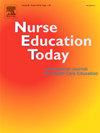提高学生的成功:一个全面的方法,以健康和学术支持通过颜色编码的算法
IF 4.2
2区 医学
Q1 EDUCATION, SCIENTIFIC DISCIPLINES
引用次数: 0
摘要
护理专业学生面临的心理健康挑战可能会因护理学校入学的苛刻性质而升级,影响学生的表现和整体健康和福祉。考虑到这些问题,一所学校开发了一种颜色编码算法,以主动解决四类学生的需求,从轻度(需要最少的支持)到严重(需要立即干预)。该算法将现有的学校、机构和社区资源与健康的十个维度结合起来,支持一个全面的健康计划,促进一个支持学生整体需求的培育环境。教师培训是健康项目成功的关键组成部分,该算法为教师提供了一个框架,可以根据个性化情况快速将学生推荐到适当的资源,加强学生、教师和健康部门之间的合作。结论早期识别和缓解潜在风险是防止问题升级的关键,从而提高学生的整体表现和结果。健康计划不仅支持学生和学校的成果,还通过培养一支精神上和情感上具备提供高质量护理能力的护理队伍,促进更好的医疗保健结果。该计划提供了一个可扩展的模型,将健康纳入各个学科,强调心理健康作为个人和职业成功基石的重要性。本文章由计算机程序翻译,如有差异,请以英文原文为准。
Enhancing student success: A holistic approach to wellness and academic support through a color-coded algorithm
Background
Mental health challenges facing nursing students can be escalated by the demanding nature of enrollment in nursing school, affecting student performance and overall health and well-being.
Procedure
These concerns led one school to develop a color-coded algorithm to proactively address four categories of student needs, from mild (requiring minimal support) to critical (requiring immediate intervention). The algorithm aligns available school, institutional, and community resources with the ten dimensions of wellness, supporting a comprehensive wellness program that promotes a nurturing environment that supports the holistic needs of students. Faculty training is a critical component of success for the wellness program, and the algorithm provides a framework for faculty to quickly refer students to appropriate resources for individualized situations, strengthening the collaboration between students, faculty, and the wellness department.
Conclusion
Early identification and mitigation of potential risks are key to preventing issues from escalating, thereby enhancing overall student performance and outcomes. The wellness program not only supports student and school outcomes but also promotes better healthcare outcomes by producing a nursing workforce that is mentally and emotionally equipped to deliver high-quality care. The program provides a scalable model for incorporating wellness across various disciplines, highlighting the importance of mental health as a cornerstone for both personal and professional success.
求助全文
通过发布文献求助,成功后即可免费获取论文全文。
去求助
来源期刊

Nurse Education Today
医学-护理
CiteScore
6.90
自引率
12.80%
发文量
349
审稿时长
58 days
期刊介绍:
Nurse Education Today is the leading international journal providing a forum for the publication of high quality original research, review and debate in the discussion of nursing, midwifery and interprofessional health care education, publishing papers which contribute to the advancement of educational theory and pedagogy that support the evidence-based practice for educationalists worldwide. The journal stimulates and values critical scholarly debate on issues that have strategic relevance for leaders of health care education.
The journal publishes the highest quality scholarly contributions reflecting the diversity of people, health and education systems worldwide, by publishing research that employs rigorous methodology as well as by publishing papers that highlight the theoretical underpinnings of education and systems globally. The journal will publish papers that show depth, rigour, originality and high standards of presentation, in particular, work that is original, analytical and constructively critical of both previous work and current initiatives.
Authors are invited to submit original research, systematic and scholarly reviews, and critical papers which will stimulate debate on research, policy, theory or philosophy of nursing and related health care education, and which will meet and develop the journal''s high academic and ethical standards.
 求助内容:
求助内容: 应助结果提醒方式:
应助结果提醒方式:


